While the sport appears leisurely, there are many kayaking dangers. In recent years, the number of paddling fatalities has risen with the U.S peaking in 2015 when 139 people perished in kayak or canoe-related incidents.
But it’s never been easier to practice good kayak safety habits. Taking the necessary precautions and bringing the proper gear can save your life.
In this article, we’ll discuss the tenets of kayaking safety. We’ll show you what gear to pack, proper clothing to wear, and rescue techniques.
Also, be sure to take a lesson with a Certified Kayaking Instructor before going on the water for the first time.
Basic Kayak Safety Rules
- Tell someone where you’re going and when you’ll be back
- Always wear a life jacket
- Bring more clothing, food, and water than you need
- Know how to use a paddle float or similar safety equipment
- Paddle with someone unless able to do wet exit and re-entry recoveries
- Make safe, responsible changes to your trip if conditions or weather changes
Kayak Safety – What You Need
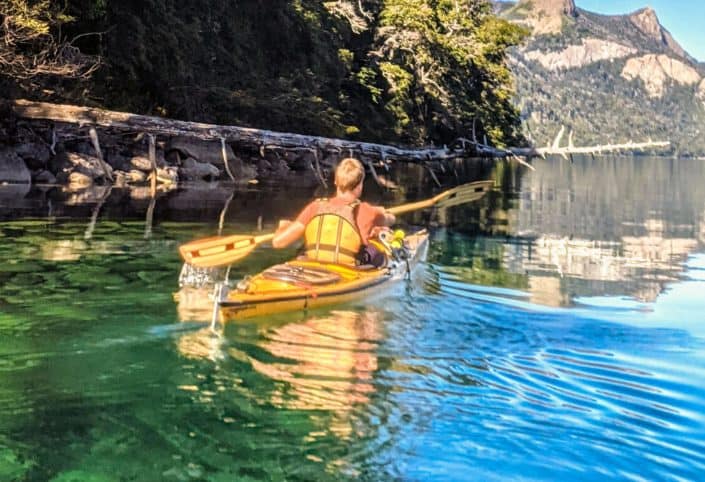
At a minimum, you should wear a life jacket at all times. This is the most basic and most important practice. Bring along additional safety gear like a paddle float and know how to use them.
Always let at least one person know where you’re going and when you plan on being home. Make sure your gear and kayak are in good condition before heading out.
Just following these simple rules will help you avoid the majority of incidents you encounter. Of course, there’s much more you can do to be a safer paddler. We’ll get more in-depth below.
Best Safety Precautions & Accessories
Life Jackets
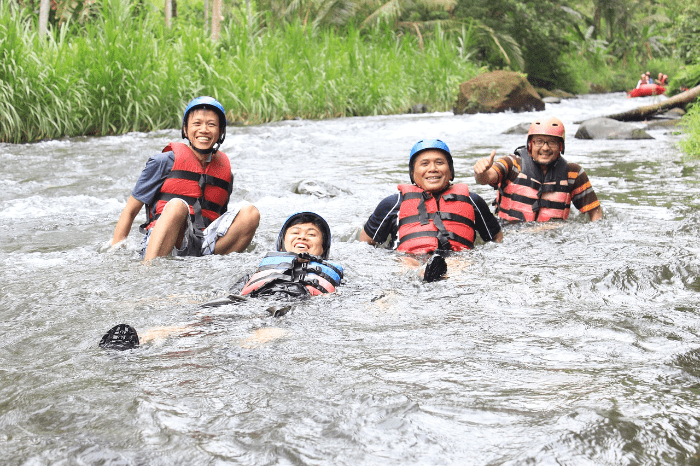
No matter the weather, your paddling experience, or the water temperature, there’s no reason not to wear a life jacket.
According to the United States Coast Guard (USCG), 80% of drowning victims weren’t wearing a life jacket.
Even if you consider yourself a strong swimmer, a life jacket can save your life by keeping you buoyant if you have to swim some distance or are knocked unconscious.
Float Plan
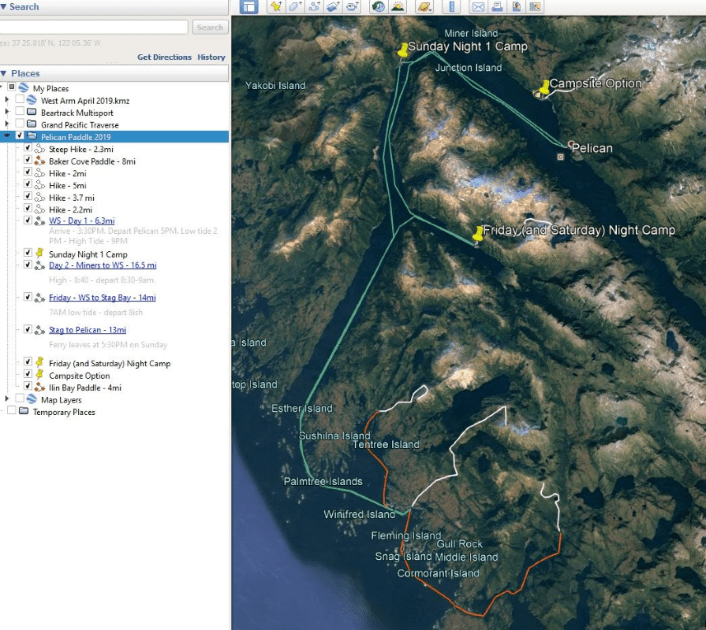
This should be part of your pre-trip routine. All you have to do is tell someone where you’re going and when you plan to be back. Make sure they know the color of your kayak, life jacket, and any camping gear.
Don’t Drink and Paddle
A lot of safety habits you practice driving a car apply to kayaking. The most obvious being don’t paddle under the influence. Alcohol is the leading contributing factor in boating accidents.
Trip Planning
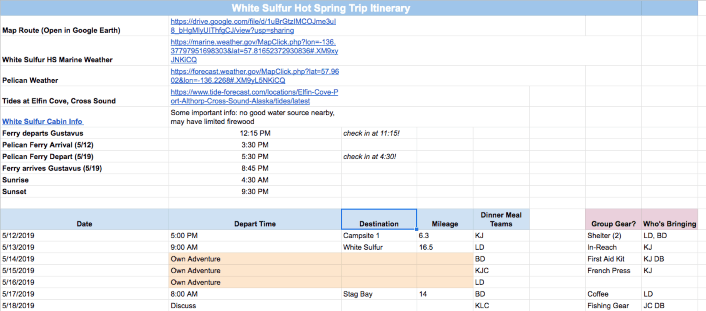
When planning your trip, whether for a day, a night, or a week, have an honest assessment of your skill level. What sort of water will you be paddling on? If the wind picks up, what direction will it come from?
If planning a river trip, ask how much it’s been raining and what the current water level is like. If you’re paddling in a region with prominent tides and currents, have a thorough understanding of their characteristics.
Bear in mind that distances look shorter over water than over land. Calculate your projected mileage and how long it should take. A good baseline in a sea kayak is about 2.5 miles an hour in neutral conditions.
If traveling with someone, ask their opinion. If there’s a disagreement, defer to the more conservative option. There’s always time for the more challenging endeavor as you gain experience.
Spray Skirt
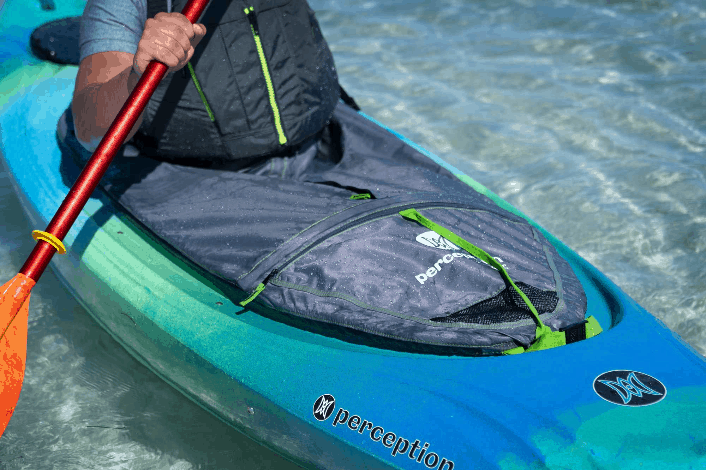
This is for those paddling sit-in kayaks. Spray skirts are made of water-resistant fabric and worn beneath your life jacket. A bungee cord is stitched into the “skirt” perimeter and wraps around the lip of the cockpit.
The skirt − or “spray kilt” as some gentlemen may prefer to think of it - keeps splashing waves and rain from filling the cockpit. The more water in a boat, the less stable it becomes.
They’re a necessity for any ocean paddles where waves or surf can swamp your boat. The same can be said for river paddles with the potential for rapids and whitewater.
Helmet
While the odds of needing a helmet in a sea kayak or on a lake are slim, they’re as important as a life jacket for whitewater trips. Even the best paddlers can make mistakes, misjudge a rapid, flip, and strike their head on a rock.
First-Aid Kit
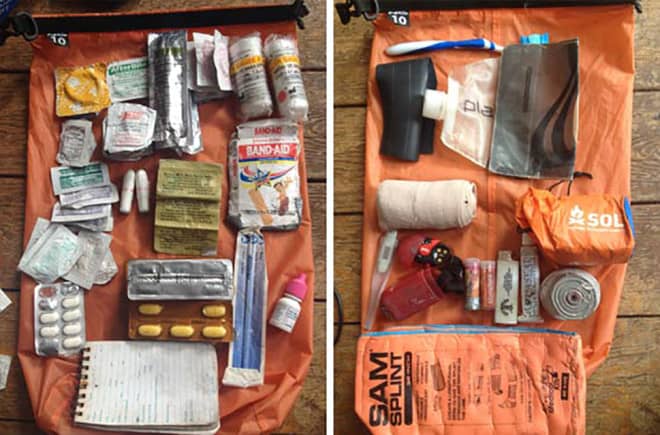
The further from help you’ll be, the more exhaustive your first-aid kit. Make sure you have several pairs of latex gloves so you can safely administer care to others.
Moleskin or a similar anti-blister band is invaluable where your hands rotate and chafe around the paddle.
Basic anti-inflammatories like Tylenol help with most aches and sores.
An ace bandage and assortment of band-aids should be a staple of any first-aid kit. Medical scissors, gauze, tweezers, and antibiotic cream will help with most cuts or abrasions.
If someone has allergies, make sure their medication is readily available.
If you plan on building a fire, bring along some anti-burn cream.
Paddle Float
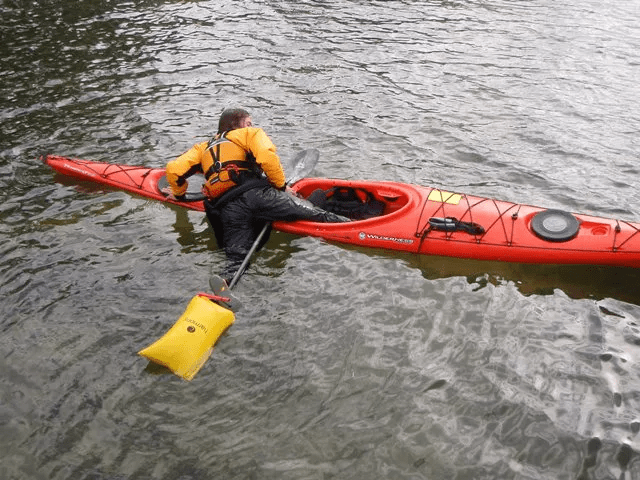
Here’s how to self-rescue using a paddle float
No bigger than a t-shirt, a paddle float is the best tool for re-entry. When inflated, the float fits over your paddle’s blade and makes it buoyant. It works as an outrigger, providing stability and a brace to help you re-enter your kayak.
Flotation Bag
Most sea kayaks have spacious bow and stern hatches to store gear for long trips. While their hatch covers are designed to keep water out, a capsize can still fill them. If there’s nothing in the hatches, these waterlogged compartments make re-entry harder.
Flotation bags are placed in empty hatches and filled with air, providing buoyancy and keeping water out.
Bilge Pump
These handheld devices remove excess water from your kayak’s hatches and cockpit. Depending on your recovery technique you may be able to empty a lot of the water from your cockpit before re-entering.
The pump will remove most of the remaining water which improves stability and helps you get to shore.
Tow Lines
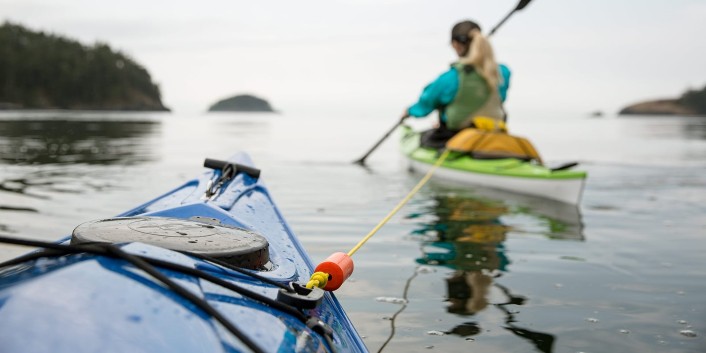
Great if your paddle partner gets in trouble or is tiring. Tow lines come connected to a belt worn around your torso and the line coiled in a bag. If needed, the line can be tossed to the stricken kayaker who can either hold it or secure it to their boat.
NEVER tie a tow line to your boat. In case of an emergency you want to be able to release the belt to disconnect from the towed kayak.
Knife
A staple for any outdoor activity. You never know when you’ll need to cut a line, a bandage, kindling, or anything else that requires a blade. Many life jackets come with special tabs where you can holster one.
Whistle
Another accessory that can be easily attached to your life jacket. Great for either signaling help or getting the attention of your fellow paddlers.
Signaling Device
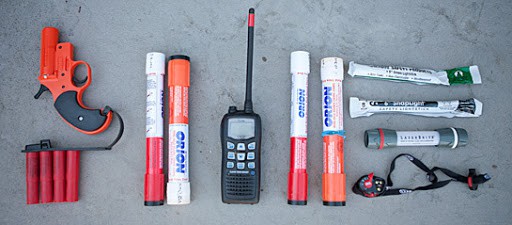
This can be any number of items and it’s not a bad idea to carry several. Marine radios are monitored by nearby boaters and the coast guard. Reflective mirrors, flares, and similar tools can be used to wave down nearby mariners.
Paddling Attire
No matter what the day’s weather looks like, remember you’re dressing for the water temperature. If you’re planning on paddling in cold water and have access to it, a wet or dry suit extends the amount of time you can be immersed before hypothermia sets in.
Bring extra layers. Splashing water and unexpected windy conditions can make you cold even if you don’t capsize. Wear wool or similar materials that wick water and keep it off your skin.
Paddle With a Friend
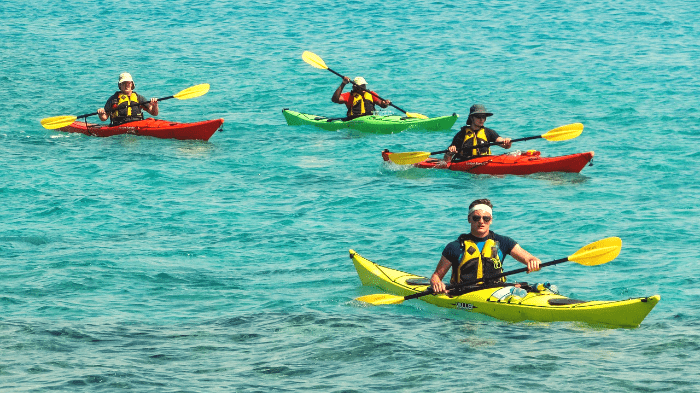
I understand this isn’t always possible. And if you’re going to the protected local lake for a quick paddle it may not be necessary. If you plan on doing anything that challenges your experience level, bring a friend.
Assisted rescues are infinitely easier than solo ones. Having someone to tow or assist you to safety can make the difference.
It’s also nice if you’re deliberating where to go or what the conditions are like. Having another perspective and opinion can make the decision easier and prevent you from making a foolish one.
Local Weather and Hazards
There’s no such thing as too much information. Even if you’ve paddled the area before, consult with anyone who’s paddled it recently. Waterways are dynamic and change quickly.
If you’re paddling somewhere new, learn as much as you can about the area. If there’s a guide or rental shop nearby, ask their opinion, what they’ve been seeing, etc. Even if you’re not renting from them, most guides are happy to talk about paddling and water conditions.
Wet Exit & Re-Entry
Learning how to wet exit and re-enter your kayak is paramount to stay safe even if you capsize.
The best way to learn is to practice it yourself. Watch the videos below, and go to a protected area with a friend to work on your recovery techniques.
Environmental Hazards
Apart from all the safety precautions above, you should also know the most common environmental hazards so you can be fully prepared.
Sun Exposure
You burn faster when you’re on the water due to the sun reflecting off the surface and back up. Bring sunglasses and a brimmed hat to deflect the glare. Don’t be shy about using sunscreen. If you’re gone for multiple days, bring aloe vera to alleviate any burns.
Dehydration
Increased sun exposure increases the need for fluids. My rule of thumb is to have two days of water on hand. A water shortage makes any situation worse and can pressure you into bad decisions.
Hypothermia
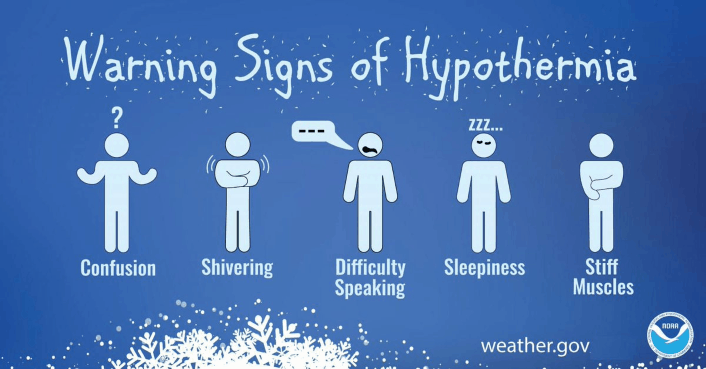
Although more prevalent in the upper latitudes, hypothermia is possible regardless of water conditions. Even “warm” water is cooler than your body temperature. Over time, the water will pull heat from your body.
Put together a “hypo bag” with dry clothes including a hat, gloves, and a sleeping bag.
Strainers and Sweepers
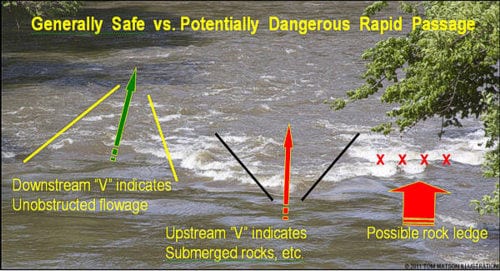
How To Spot Strainers and Sweepers
This refers to trees that extend from the riverbank and into the river. Strainers are submerged trees while sweepers are mostly above the waterline.
Strainers are like a big colander. The branches allow water to flow through but catch and disrupt solid objects and can upend kayaks or trap fallen paddlers.
Undercut Rocks
As river currents erode the rocks, they create underwater caves that can be filled with debris. Consulting guides and fellow paddlers is the best way to identify them as they’re tough to see once on the river.
If you suspect one’s ahead, look for indicators like a weak eddy downstream of the boulder. Water not “pillowing” upstream is another warning sign of an undercut rock.
Other Boats
As a non-motorized vessel, kayaks have the right-of-way. Sadly, not all boaters know this. Like driving, it’s best to paddle defensively. When possible, give boats a wide berth and use your radio to communicate your intentions.
If you’re worried about a potential collision, monitor the oncoming vessel. Imagine your kayak as a clock with the bow pointed at 12 o’clock. If the “time” of the oncoming boat doesn’t change, you’re on course for a collision.
Currents & Tides
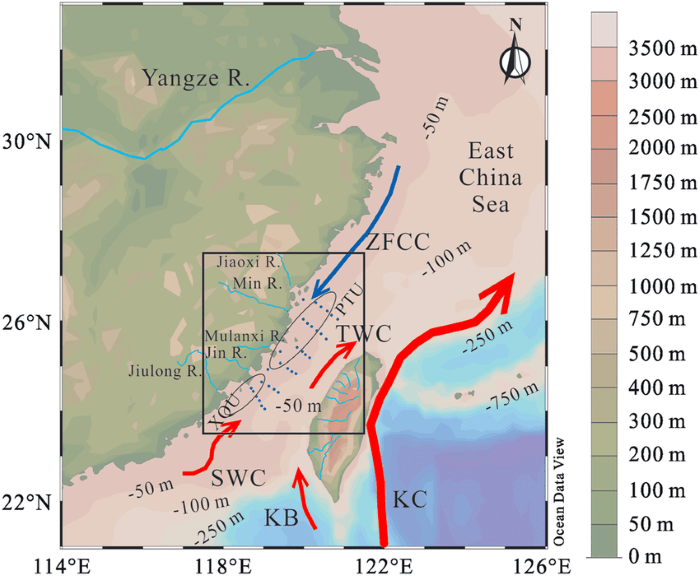
Rivers and oceans can have dynamic currents and tides that can overpower a kayak. Watch the water ahead of you for changing conditions. Look for ripples or lines in the water that indicate a changing current or shift in the tide’s behavior.
Like many of these factors, the best practice is to be prepared by talking with locals and consulting guide books for in-depth information. Current and tides can be subtle and you may not notice the effect they’re having until it’s too late.
Kayak Safety – Conclusion
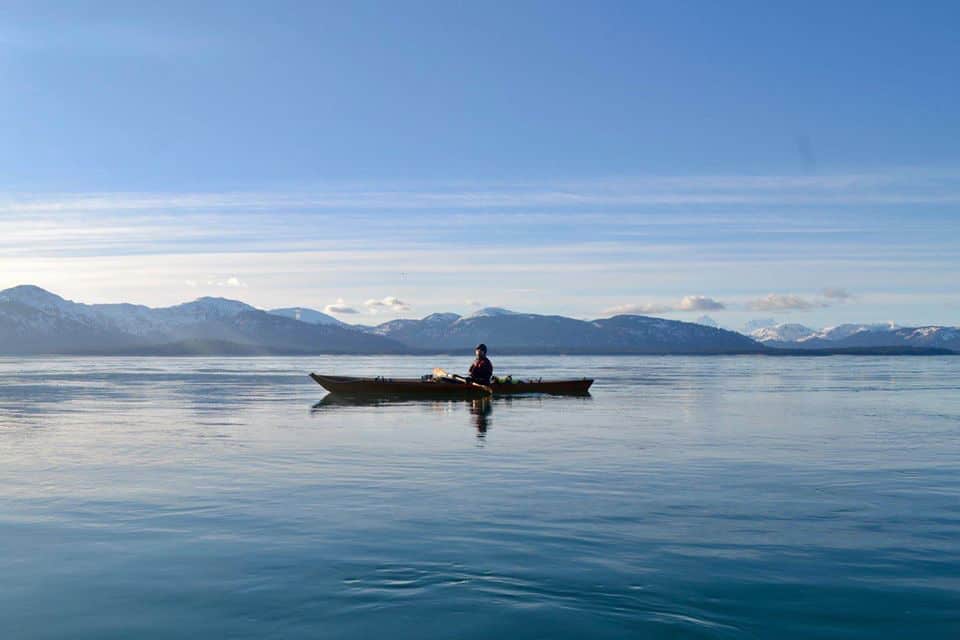
With the proper practices and routines, kayaking is an activity that you can safely enjoy as you increase your experience level.
Hopefully, after reading this you feel better prepared and will be more aware of your surroundings the next time you push off from the beach.
Keep yourself and fellow paddlers safe by sharing your thoughts, tips, and hints in the comments below and share with others if you found it helpful.

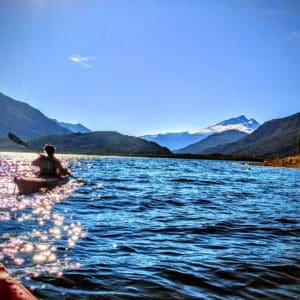
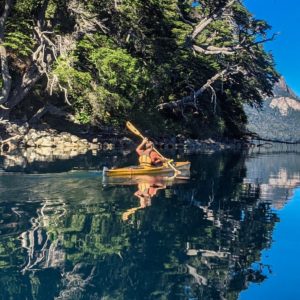

This Post Has One Comment
Do you know you are using my videos for wet exit and re enter and roll? No problem just wondered. You never suggest taking a lesson from an accredited instructor either. There are a few edits that would benefit this but the idea and motivation is great, cheers Mike Aronoff ACA ITE